The Parti-Coloured Cocker Spaniel
As stated in the current breed standard, colours of the Cocker Spaniel are described as
“Various. In self colours no white allowed except on chest”
The Cocker Spaniel is a breed that has a vast variation in coat colour and markings, and are categorised in two groups - the solid colours and the parti-coloureds.
The Parti-Coloured Cocker Spaniels’ various colours are as follows :

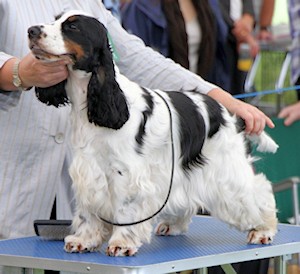
Black & White (Left), Black, White And Tan (Right)
photos © Shel Cowles

Liver/Chocolate & White
photo courtesy of Linda Reed
Liver/Chocolate, White & Tan
(awaiting photo)
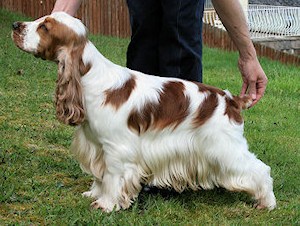

Orange & White (left), Orange Roan (right)
photos © Jane Simmonds
(left), Shel Cowles (right)


Blue Roan (Left), Blue Roan And Tan (Right)
Photo of blue roan © Marion Sweeney, photo of blue roan & tan courtesy of Jennifer Lloyd-Carey
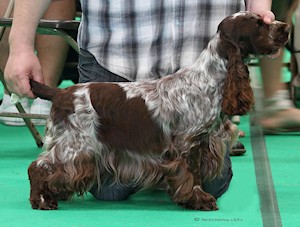

Liver/Chocolate Roan (left), Liver/Chocolate Roan & Tan
photo (left) courtesy of Marion Sweeney, photo (right) courtesy of Cayley Turner
Some of the “& white” coloured cocker spaniels may have ticking of the dominant colour factor in their coat:

Black & White with Ticking
photo courtesy of Elizabeth Craig
DEFINITION OF THE PARTI-COLOURED COLOURS
The roans are the most popular of the parti-coloured cocker spaniels and can vary from a light roan to a dark roan. The roaning is the flecking of the dominant colour in the coat, i.e. blue roan is black flecking, liver/chocolate roan is liver/chocolate flecking, orange roan is orange flecking. The blue roan is the most popular of “the roans” and is followed by orange roan then liver/chocolate roan, the latter two colours are becoming more appreciated and people’s choice over a period of time could predict their status in popularity.
The "and whites" are predominantly white with small or large patches, and in some cases may have no body patches, of the pigmented colour i.e. black, liver/chocolate, orange. The black & white is the most popular followed by orange & white then liver & white, and again people’s choice over a period of time could predict their status in popularity.
The "and tans" are identified with definite patches of tan colour above the eyes, patches/flecking of tan around the muzzle, inside of ears, on the legs and feet, and under the tail area. The blue roan & tan and black, white & tan are equally popular, followed by liver/chocolate, white & tan or liver/chocolate roan & tan, and again people’s choice over a period of time could predict their status in popularity. These coloured cocker spaniels are often referred to as “tri-coloured”.
In all the parti-coloured cocker spaniels, the areas of the main colour patching will usually cover the ears, both sides of the head and around the base of the tail. There may also be markings of the main colour in the form of patches and these can be in small or large proportions anywhere else over the neck, legs, body and hindquarters.
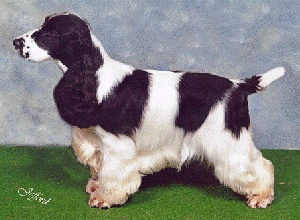
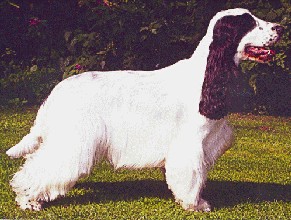
Body with patching of the black dominant colour (left), Body without patching of the dominant colour (right)
photo left © Jefford, photo right courtesy of Carol Burnet
The breed standard does not state on how the parti-coloured cocker spaniel should be marked, and in some cases there may be little colour patching on one or both ears or one or both sides of the head or body, and there may be no break in the main colour patching on the head –known as a blaze – so the head will be of the dominant colour.
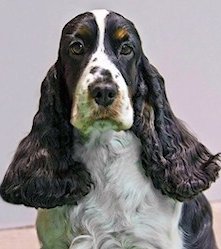

L-R Head study with Blaze and Head Study without Blaze
(break of the dominant colour on head and without a break of the dominant head colour)
photos courtesy of Marion Sweeney (left) and Elizabeth Craig (right)

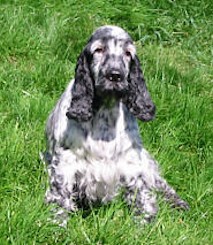
L-R Roan Head with Partial Mask and Roan Head without Mask
photos courtesy of Shel Cowles (left) and Jane Simmonds (right)
One must remember there is no such thing as a mis-marked parti-coloured cocker spaniel – it is people’s choice on their preference of markings.
As puppies, the parti-coloureds can be identified by the soles/pads of the feet: in blue roans and orange roans the pads are dark coloured – blue roans and orange roans with black pigmentation will be black, liver/chocolate roans and orange roans with liver pigmentation will be brown ; in the "and whites" the pads will be partially dark coloured – black & whites, black, white & tans and orange and whites with black pigmentation will be pink and black, liver/chocolate & whites, liver/chocolate, white & tans, orange & whites with brown pigmentation will be pink and brown.
Full and further information on all the colours of Cocker Spaniels is available on the website of The Cocker Spaniel Club (the parent breed club) HERE
